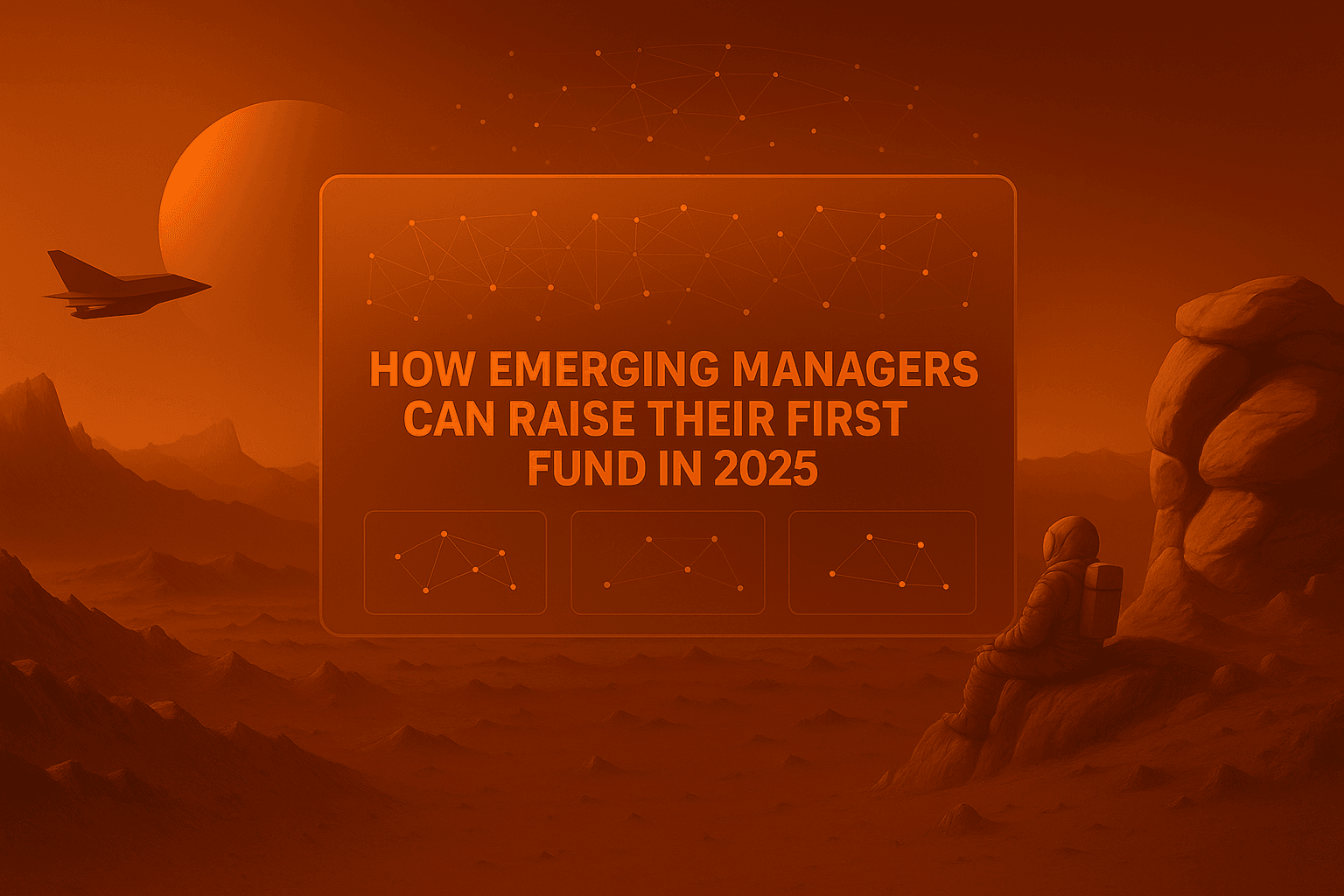How to Raise a Fund Without a Placement Agent: A Practical Playbook for Emerging Managers
A practical, economics-driven guide for emerging managers in the US and Europe who want to raise a fund without hiring a placement agent—covering when agents make sense, why most Fund I GPs won’t use them, and how to build a lean, LP-ready fundraising machine instead.

How to Raise a Fund Without a Placement Agent: A Practical Playbook for Emerging Managers
1. Why most emerging managers won’t raise with a placement agent
Talk to any allocator who backs emerging managers and you’ll hear a version of the same thing: they want to see the GP sell their own story.
For Fund I and Fund II managers in the US and Europe, there are three structural reasons why relying on a placement agent often doesn’t make sense.
1. The economics don’t line up.
Most placement agents are built for $150m–$5B funds. Boutique agents may look at mandates below that, but many prioritize fund sizes where their economics are cleaner.
The standard fee model is tough at smaller sizes:
- A success fee that often equates to roughly one year of management fees on capital raised—effectively 1.5–2.5% of commitments.
- Retainers or upfront fees, sometimes in the $15k–30k per quarter range, just to keep the relationship live.
If an agent ultimately raises $20m for you, paying $400k–600k over a few years is not unusual. For a $40–80m Fund I, that’s a significant slice of your entire management-fee budget.
2. Signaling and control.
A strong agent can open doors and compress timelines. But some LPs quietly see a very small fund that needs an agent as a mixed signal:
- Are you able to build your own LP relationships?
- Do you really understand your own positioning, or are you delegating the hard part?
- Are you already outsourcing core GP responsibilities?
It’s not a deal-breaker, but it adds questions at a time when LPs already have plenty of reasons to say “no” to new managers.
3. LPs want to diligence you, not a sales deck.
Modern LPs—especially family offices and specialist fund-of-funds—underwrite process, not just personality. They check how you construct a portfolio, manage risk, handle follow-on, and behave in down markets.
No placement agent can compensate for:
- A weak or inconsistent investment process
- A vague or overly generic thesis
- Limited understanding of the competitive landscape
At best, an agent amplifies a coherent story. At worst, they just accelerate “no” decisions.
For most Fund I managers targeting $25–100m, raising mainly from family offices and entrepreneurs across the US and Europe, the math is simple:
You’re better off building your own fundraising muscle than spending 1–2 years of your management fees outsourcing it.
2. When a placement agent can make sense
There are legitimate cases where a placement agent is rational:
- You’re targeting large institutional tickets (pensions, insurers, sovereign wealth funds) where agents have long-standing relationships you simply don’t.
- You’re raising $200m+ and need true global coverage across multiple strategies and regions.
- You’re a spin-out team with a strong track record but near-zero bandwidth, and the fee load doesn’t materially damage team economics.
Even then, the best use of an agent is as an amplifier, not the only channel. You still need:
- A strong, LP-ready narrative
- A robust data room
- Direct relationships with anchor LPs
For everyone else—particularly Fund I and smaller Fund II managers—the key question is different: How do I run a professional process without them?
3. Build your in-house fundraising machine
Think about fundraising the way a good founder thinks about go-to-market. If you were building a SaaS company, you wouldn’t outsource all sales from day one. You’d:
Define your ideal customer
Build a clear, differentiated story
Systematize outbound and follow-up
The same structure works for GPs.
Step 1: Define your LP ICP properly
“Family offices and institutions” is not an ICP. For an emerging manager, the real ICP usually looks more like:
- Entrepreneurs and operators in your domain (e.g. B2B SaaS founders if you invest in B2B SaaS)
- Single and multi-family offices with a track record of backing emerging managers or direct deals in your sectors
- Boutique fund-of-funds and secondaries that explicitly allocate to first-time managers
- Strategic LPs (corporates, holding companies) aligned with your focus
You should be able to answer, in one sentence:
“The typical LP we’re targeting is X, based in Y, writes Z-sized checks, and cares most about A, B, C.”
If you can’t, you’re not yet ready for volume outreach—agent or no agent.
Step 2: Get your story to institutional quality
LPs do not buy “we see great deal flow.” They buy:
- A clear thesis
- A coherent portfolio construction plan
- Evidence of sourcing, picking, and winning access
- A team that looks durable over a full cycle
Before you send a single outbound email, you should have:
- A concise one-pager: strategy, team, track, target size, fund terms, and minimum check sizes
- A deck that explains your edge in a straightforward way, without buzzword stacking
- A track record or credible proxies: angel deals, operator experience, advisory roles, co-investment references
- A near-final data room outline (or live data room) that can be shared quickly once LPs show interest
Emerging managers often underestimate how “institutional” even relatively small family offices have become. They are applying the same discipline to a $25m Fund I that they apply to a $1B platform.
Step 3: Build your own target list (properly)
This is where a serious LP/data platform is worth the cost.
You want a target list that is:
- Segmented by LP type (SFO/MFO/FOF), region (US, Europe, other), ticket size, and risk appetite
- Filtered by strategy and mandate (e.g. “backs first-time managers,” “likes concentrated sector funds,” “active in AI, climate, healthcare”)
- Enriched with real humans: decision-makers, not just generic info@ emails
- Continuously updated, so you don’t waste cycles on LPs that paused new commitments or left your asset class
Altss was built specifically to handle this for GPs and IR teams: over 9,000 family offices worldwide with detailed investment focus, team data, and past commitments, updated on a tight cadence using OSINT and manual verification, with Altss’s full LP module priced at $15,500 per year. For true emerging managers, there are tailored packages to keep the economics workable.
Whether you use Altss or another platform, the principle is the same: treat your LP universe as critical infrastructure, not a temporary spreadsheet.
Step 4: Design a realistic outreach engine
You don’t need 1,000 conversations. You need the right 50–150.
A simple segmentation for Fund I:
- 50–80 Tier 1 LPs you’d love as anchors
- 50–100 Tier 2 LPs with smaller tickets or more flexible mandates
- 50–100 long-term relationship LPs for Fund II and beyond
For each segment, define:
- Who in your team owns the relationship
- What the angle is (sector alignment, co-invest track, geography, timing)
- How often you’ll touch them and with what content (quarterly letters, specific deal commentary, market updates)
You can run this on a basic CRM, a spreadsheet, or inside your data platform. The key is consistency.
4. A 6–9 month no-agent fundraising roadmap
If you’re starting now, here’s a realistic, self-directed roadmap for an emerging manager in the US or Europe.
Month 0–1: Foundations
- Finalize fund terms, strategy articulation, and core materials
- Define LP ICP and build the first version of your target list
- Clean up your digital footprint: website, GP bios, public track if available
Month 2–3: Calibration
- Hold 10–20 conversations with friendly LPs and peers specifically to stress-test your story
- Tighten the deck and data room based on feedback
- Soft-circle early believers (ex-founders, operator angels, a handful of family offices)
Month 4–6: Heavy outreach
- Work through your Tier 1 and Tier 2 target lists systematically
- Aim for 5–10 substantive LP interactions per week (not just “coffee chats”)
- Maintain a simple pipeline: Intro → Deep Dive → Diligence → IC → Close
Month 7–9: Closing momentum
- Prioritize LPs whose decision processes fit your calendar
- Run weekly check-ins with near-final LPs, clarifying what’s left to answer
- Use references—from portfolio founders, co-investors, and prior LPs—to unlock final approvals
By the end of this cycle, even if you decide to work with a placement agent in the future, you’ll have an internal fundraising muscle that no third party can replace.
5. Where a family office database really fits (and where it doesn’t)
A family office database is not a magic “LP tap.” It is a:
- Coverage layer: a structured map of the LP universe
- Intelligence layer: context on what they actually do and when
- Workflow layer: tools to run a disciplined fundraising process as a small team
It does not replace:
- Your thesis
- Your track record
- Your ability to build trust with capital allocators
The right platform makes it realistic to behave like a professional fundraising organization from Fund I onward, without hiring a five-person IR team or outsourcing your future economics to an agent.
6. FAQ: Fundraising without a placement agent
1. What fund size is “too small” for a placement agent?
Below roughly $150m, many agents will either struggle to justify the time or load more cost onto retainers and success fees. For a $25–80m Fund I, the economics are often hard to justify unless you have very specific needs.
2. Will LPs penalize me for not having an agent?
No. Many LPs actually prefer that GPs own their fundraising and relationship management directly. What they penalize is disorganization: unclear process, inconsistent follow-up, weak materials.
3. How many LP meetings should I expect for a successful close?
There’s no universal rule, but many emerging managers report needing 3–5 serious LP relationships per $10m of capital raised, depending on average ticket sizes. That often translates into 50–150 real LP conversations over the life of the raise.
4. Should I pay a “finder” for one or two LP intros?
Be cautious. Anything that looks like transaction-based compensation for selling securities can have regulatory implications, especially in the US. It can also create alignment issues with LPs. Always structure this with proper legal advice.
5. What’s the biggest mistake managers make without an agent?
Two things: spray-and-pray outreach with a generic deck, and under-communicating with warm LPs. If someone is doing work on your fund, they should hear from you regularly with substantive updates.
6. How does a tool like Altss fit this strategy?
Altss gives you verified coverage and context on 9,000+ family offices, updated on a tight cadence, with a pricing model that starts at $15,500/year for the full LP module and tailored options for emerging managers. It doesn’t replace your story, but it does give you the structural advantage of knowing who to talk to, when, and how to prioritize your time.
CTA:
If you’re a Fund I–III manager in the US or Europe and want to see what a self-directed, data-driven fundraising process looks like in practice, you can always request a short Altss walkthrough and use it as a benchmark—even if you end up choosing another path.
Related articles

Anchor Investors for Emerging Managers & Startups: The 2025 Playbook
A step‑by‑step playbook for landing an anchor investor (or LP), understanding anchor vs. lead, structuring first closes, and creating momentum in your round.

How Emerging Managers Can Raise Their First Fund in 2025
How emerging managers can raise their first fund in 2025: a precise, step-by-step playbook that covers allocator targeting, pipeline math, ILPA-aligned diligence, OSINT signals, and modern outreach. Written for GPs and IR teams using verified allocator data and real-time LP coverage.